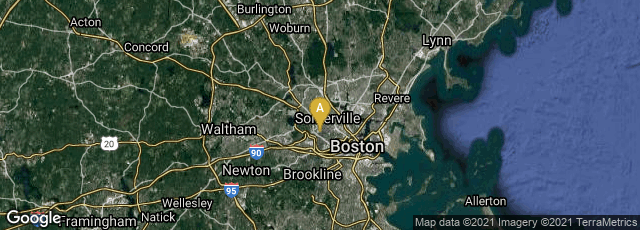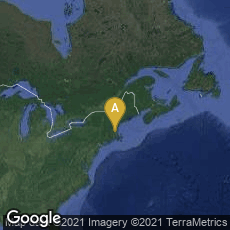

A: Cambridge, Massachusetts, United States
"The Connection Machine CM-1 was the first commercial supercomputer designed expressly for problems of Artificial Intelligence (AI). A massively parallel supercomputer with 65,536 processors, it was the brainchild of Danny Hillis, conceived in the early 1980s while he was a doctoral student with Marvin Minsky at the MIT Artificial Intelligence Lab, and built at his start-up Thinking Machines Corporation. Departing from conventional computer architecture of the time, the CM-1 was modeled on the structure of a human brain: rather than relying on a single powerful processor to perform calculations one after another, the data was distributed over the tens of thousands of simple 1-bit processors, all of which could perform calculations simultaneously, an architecture known as Single Instruction Multiple Data (SIMD).
"What enabled the processors to communicate faster than previous SIMD designs was the internal network, a 12-dimensional boolean n-cube structure suggested by Nobel Prize physicist Richard Feynman, who spent his summers working with us. Within this hardwired physical structure, the software data structures for communication and transfer of data between processors could change as needed depending on the nature of the problem. The connections between processors were more important than the processors themselves, hence the name "Connection Machine."
"In 1987 the CM-1 was superceded by the more powerful CM-2 in the same package and similar architecture. In 1991 the CM-1/CM-2 hypercube design was superceded by the CM-5, with a very different form and architecture. Each in their day won the prestigious Gordon Bell Prize as the most powerful supercomputers in the world, the CM-2 in 1989 and the CM-5 in 1993.
"Visual design of the Connection Machines CM-1/CM-2:
"From 1983-1985 I directed the packaging and industrial design of the Connection Machine CM-1 at Thinking Machines Corporation, working with industrial design consultants Allen Hawthorne and Gordon Bruce, and mechanical engineering consultant Ted Bilodeau. The CM-2, released in 1987, was a more advanced successor (including floating point hardware) contained in the same physical package.
"The form of the machine was to express both its function and the passions of its creators: the dream of producing a "Machina Sapiens," a new genus of living, thinking machines. For a description of the design history, theory and concepts behind the visual design, see my article:
"How the Connection Machine inspired Steve Jobs:
"My old friend Joanna Hoffman was marketing manager for the first Macintosh and the NeXT computer, and Steve Jobs' "right hand," as depicted by Kate Winslet in the film "Steve Jobs." In 1986, when the Connection Machine came out, Jobs asked her to get its designer to create his new NeXT computer as well. To which Joanna replied, "Too late, Tamiko has gone to Europe to become an artist!" But the machine made a lasting impression on him, and from that point on, Jobs' designs were not merely useful - they were visually sublime.
See "CM-1/CM-2 Design Legacy" >>
"Yale Professor David Gelernter describes the CM as sculpture:
"There have even been heroes of computer design: The CM-1 and CM-2 parallel supercomputers of the 1980s, designed by a team headed by Tamiko Thiel, were elegant and fascinating. At Yale, visitors stopped by the machine room often to admire the thing just as sculpture." Gelernter, David. "Beyond the Grey Box," ID Magazine, Vol. 45 #2, March/April 1998, page 60.
"Connection Machines Legacy - an Untold Story in the History of AI
"In the early/mid 1980s both AI and parallel processing were considered of interest only for ivory tower academics, not for real world computing and problem solving. Danny Hillis' radical new approach to computing, however, attracted scientists to Thinking Machines who saw the value and the promise of a computing paradigm that focused on the structures required by the data itself, rather than faster and faster serial processors.
"Today's History of AI timelines omit the work that Danny and other scientists did at Thinking Machines and on the Connection Machines. Their contributions have been forgotten. But my interviews with several colleagues reveal how the ideas, the programming techniques, the software and the hardware shaped the technology of the world today. A few examples:
Brewster Kahle talks about his term "Big Data" and how he used the Connection Machine to develop the first natural language search engine.
Danny Hillis talks about how Google became the world's premiere search engine and AI company, first using parallel programming techniques that Sergey Brin learned on a Connection Machine, and then with the acquisition of Danny's subsequent company MetaWeb - whose CTO John Giannandrea is now Google's head of AI.
Even the hardware enabling Deep Learning today consists of chips that are in essence miniature Connection Machines, as are the GPUs built by nVidia that enable the success of virtual reality now, 30 years later.
"See "Connection Machine Tech Legacy" interviews >>
"Existing machines:
"At its height, I have heard there were various Connection Machines (CM-1, CM-2, CM-2a, CM-200 and the successor CM-5 in a completely different package design) at 70 installations around the world. The following machines have been preserved in museum collections. Machines are not always on exhibit - see notes.